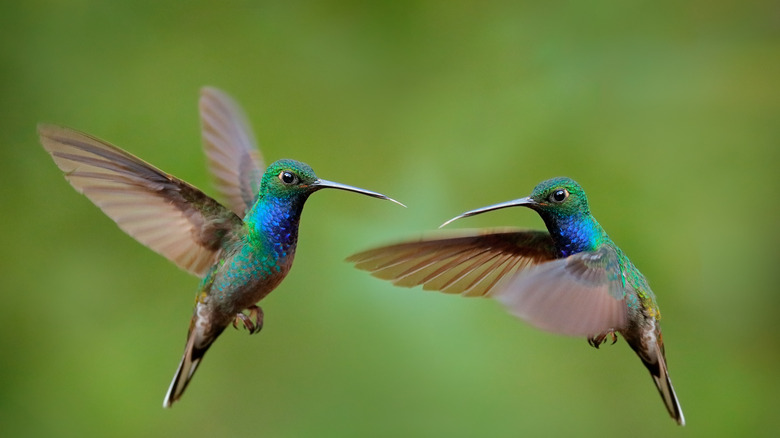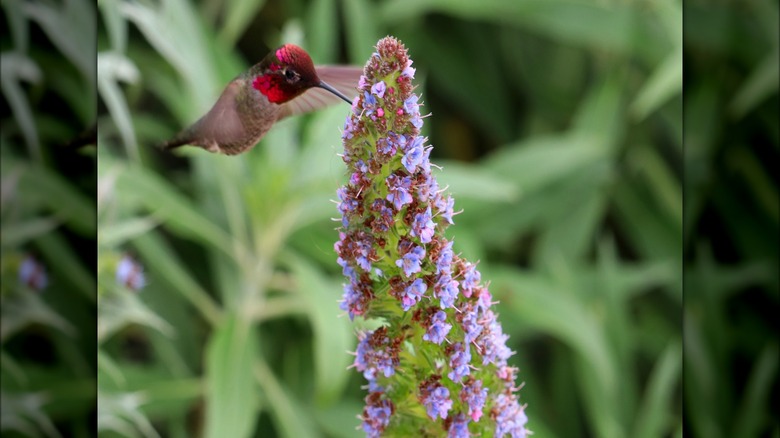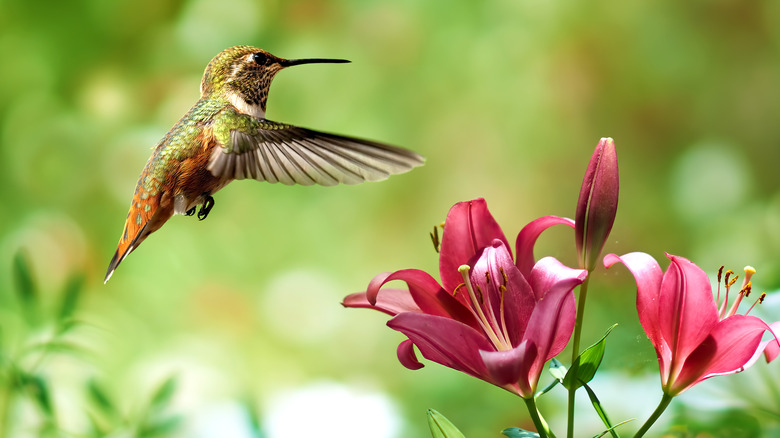The Sun-Tolerant Perennial That Will Attract Hummingbirds To Your Yard
Hummingbirds are incredible creatures with feathers that shine in the spring sun. In warmer southern states, hummingbirds may be seen as early as winter, but for most of the United States, spring welcomes these flying friends. Bird feeders entice many species, but hummingbirds are after nectar, not seeds. If you want to attract hummingbirds to your yard, try growing plants from the perennial Veronica genus. It's an inviting group of flowers with many species, and chances are, there's one that you and your new bird buddies will enjoy.
Many people attempt to attract hummingbirds through special feeders, usually consisting of an inverted bottle and reservoir. The reservoir holds nectar or sugary water. Placing one outside is a good way to encourage more visits, but native plants are even better. Many Veronica cultivars are native to the United States. When flying through the air, hummingbirds use their advanced sight to spot brightly colored flowers. Since they cannot smell, the vivid color attracts them to investigate a plant. Veronica comes in pinks, purples, blues, and whites. Most cultivars have tubular flowers that grow vertically in a spire, making Veronica easily spotted from above. By planting it in your garden, you effectively light a beacon for nectar drinkers.
Grow Veronica to attract hummingbirds
Veronica, also called speedwell, is easy to grow and does best in full sun but can tolerate partial shade for some of the day. It thrives in a variety of soil types with a range of pHs, but certain cultivars do better in sandy, loamy, or clay soil. Like many flowers, however, it does require moist but well-draining soil to prevent root fungus. Most of the time, Veronica is started indoors and transplanted outdoors after the first frost.
To add Veronica to your garden, start seeds six weeks before the last frost. Your last frost depends on your region but this date typically falls sometime within the month of April. Plant seeds in a potting mix specifically for seeds and keep the soil moist. Once the risk of frost has passed, transfer the seedlings outside. Veronica grows happily in a garden bed, or opt for a container if you'd rather avoid its spread. Position the plant where it will receive at least six hours of direct sunlight each day. Water the soil when it becomes dry.
Consider planting a hummingbird garden
Veronica is but one of many flowers that will attract hummingbirds. You can create a hummingbird garden with a range of plants that offer nectar. The best flowers are the ones that are native to your area and grow in a tubular shape. Native plants provide essential nutrients to the birds and pollinators that support your local ecosystem. Hummingbirds are drawn to bright colors, but red seems to be their favorite. With that in mind, consider planting red columbines. There are multiple cultivars native to North America. The red varieties have more sugar than other columbines. They're sure to be a hit, as will lupines, which are a hummingbird magnet.
Hot pink bee balm flowers, native to USDA zones 4 to 9, are also popular with hummers. Like Veronica, bee balm, and columbine prefer full sun, which could present an issue if you have a shadier garden. For shadier areas, consider cardinal flowers. These nectar flowers will thrive in partial shade. Toad lilies, coral bells, and ginger lilies all need dappled or partial sun and shade as well.
Don't worry if you lack space for an actual garden. Hummingbirds will also visit inviting flower boxes. A benefit of planting native plants is that their nectar does not become stale. Bird feeders with sugar water need to be safely cleaned and replenished regularly. You may find that growing native plants is simpler and more enjoyable than having a feeder.


